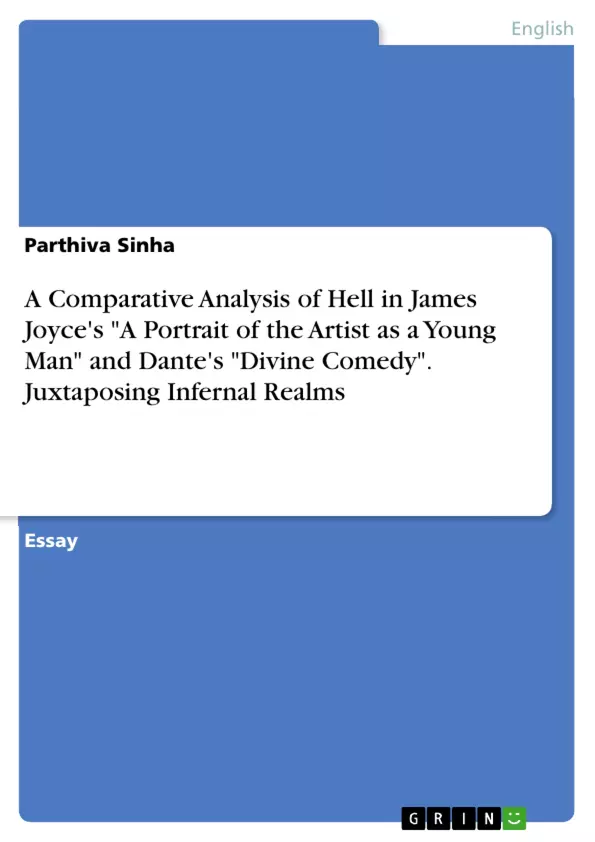This essay examines the comparative analysis of Hell as presented in James Joyce's "A Portrait of the Artist as a Young Man" and Dante's "Divine Comedy". It explores the thematic, symbolic, and allegorical elements employed by the authors in their respective works. The essay provides a brief overview of the literary context and historical background of both texts, highlighting the significance of studying and comparing their depictions of Hell. It analyses Joyce's portrayal of Hell, focusing on characters, symbolism, and underlying themes such as guilt, sin, and redemption. Similarly, it delves into Dante's intricate depiction of Hell, exploring the nine circles, punishments, and theological aspects embedded within. The essay then offers a comparative analysis, discussing the shared themes and symbolic representations as well as the divergences influenced by cultural and personal contexts. Through this analysis, the essay enhances our understanding of Hell as a literary construct and illuminates the unique perspectives and artistic choices of Joyce and Dante.
Inhaltsverzeichnis (Table of Contents)
- Introduction
- Background and Significance
- Hell in Joyce's A Portrait of the Artist as a Young Man
- Hell in Dante's Divine Comedy
- Comparative Analysis: Juxtaposing Infernal Realms
Zielsetzung und Themenschwerpunkte (Objectives and Key Themes)
This essay aims to analyze the portrayal of Hell in James Joyce's *A Portrait of the Artist as a Young Man* and Dante Alighieri's *Divine Comedy*, examining the thematic, symbolic, and allegorical elements employed by each author. Through a comparative analysis, the essay seeks to uncover shared narratives and unique artistic choices, enhancing our understanding of Hell as a literary construct.
- The literary and historical context of each work.
- The distinct visions of Hell presented in each text.
- The thematic and symbolic representations of sin, guilt, and redemption.
- The cultural and personal influences on each author's depiction of Hell.
- The enduring human preoccupation with morality and the afterlife.
Zusammenfassung der Kapitel (Chapter Summaries)
The essay begins by introducing the concept of Hell as a literary construct and highlighting the significance of studying and comparing Joyce and Dante's depictions. It then provides a brief overview of the literary context and historical background of both works, emphasizing the influence of medieval Catholicism on Dante's *Divine Comedy* and the modernist movement on Joyce's *A Portrait of the Artist as a Young Man*. The essay further delves into the specific portrayals of Hell in each work, examining the characters, symbolism, and underlying themes.
In the section dedicated to Joyce's novel, the essay focuses on how Hell is depicted through a series of vivid and disturbing visions experienced by the protagonist, Stephen Dedalus. These visions reflect Stephen's internal conflicts and his evolving relationship with Catholicism. The characters encountered in Hell represent various aspects of Stephen's psyche and societal influences, with particular attention given to the tormentor, Wells, who embodies Stephen's guilt and fear. The essay also explores the symbolism of fire and the allegorical elements employed in Joyce's depiction, emphasizing how the descent into Hell represents Stephen's inner conflict and growth.
The section dedicated to Dante's *Divine Comedy* examines the nine circles of Hell and the punishments assigned to different sins. The essay discusses the theological and philosophical aspects embedded within Dante's vision of Hell, highlighting the poem's significance as a theological and philosophical exploration of sin, salvation, and divine justice.
Schlüsselwörter (Keywords)
This essay focuses on the concept of Hell as a literary construct, exploring the thematic, symbolic, and allegorical elements employed by James Joyce and Dante Alighieri in their respective works. Key terms include: Hell, comparative analysis, symbolism, allegory, themes, guilt, sin, redemption, medieval Catholicism, modernist movement, artistic choice, literary context, historical background, and human experience.
- Quote paper
- Parthiva Sinha (Author), 2022, A Comparative Analysis of Hell in James Joyce's "A Portrait of the Artist as a Young Man" and Dante's "Divine Comedy". Juxtaposing Infernal Realms, Munich, GRIN Verlag, https://www.grin.com/document/1407829



